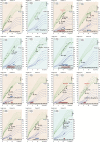Temple syndrome: comprehensive molecular and clinical findings in 32 Japanese patients
- PMID: 28640239
- PMCID: PMC5729347
- DOI: 10.1038/gim.2017.53
Temple syndrome: comprehensive molecular and clinical findings in 32 Japanese patients
Abstract
PurposeTemple syndrome (TS14) is a rare imprinting disorder caused by aberrations at the 14q32.2 imprinted region. Here, we report comprehensive molecular and clinical findings in 32 Japanese patients with TS14.MethodsWe performed molecular studies for TS14 in 356 patients with variable phenotypes, and clinical studies in all TS14 patients, including 13 previously reported.ResultsWe identified 19 new patients with TS14, and the total of 32 patients was made up of 23 patients with maternal uniparental disomy (UPD(14)mat), six patients with epimutations, and three patients with microdeletions. Clinical studies revealed both Prader-Willi syndrome (PWS)-like marked hypotonia and Silver-Russell syndrome (SRS)-like phenotype in 50% of patients, PWS-like hypotonia alone in 20% of patients, SRS-like phenotype alone in 20% of patients, and nonsyndromic growth failure in the remaining 10% of patients in infancy, and gonadotropin-dependent precocious puberty in 76% of patients who were pubescent or older.ConclusionThese results suggest that TS14 is not only a genetically diagnosed entity but also a clinically recognizable disorder. Genetic testing for TS14 should be considered in patients with growth failure plus both PWS-like hypotonia and SRS-like phenotypes in infancy, and/or precocious puberty, as well as a familial history of Kagami-Ogata syndrome due to maternal microdeletion at 14q32.2.
Conflict of interest statement
The authors declare no conflict of interest.
Figures



Similar articles
-
Temple Syndrome: Clinical Findings, Body Composition and Cognition in 15 Patients.J Clin Med. 2022 Oct 25;11(21):6289. doi: 10.3390/jcm11216289. J Clin Med. 2022. PMID: 36362517 Free PMC article.
-
Molecular characterization of temple syndrome families with 14q32 epimutations.Eur J Med Genet. 2020 Dec;63(12):104077. doi: 10.1016/j.ejmg.2020.104077. Epub 2020 Sep 30. Eur J Med Genet. 2020. PMID: 33010492
-
Temple syndrome as a differential diagnosis to Prader-Willi syndrome: Identifying three new patients.Am J Med Genet A. 2018 Jan;176(1):175-180. doi: 10.1002/ajmg.a.38533. Epub 2017 Nov 21. Am J Med Genet A. 2018. PMID: 29159982
-
Kagami-Ogata syndrome: a clinically recognizable upd(14)pat and related disorder affecting the chromosome 14q32.2 imprinted region.J Hum Genet. 2016 Feb;61(2):87-94. doi: 10.1038/jhg.2015.113. Epub 2015 Sep 17. J Hum Genet. 2016. PMID: 26377239 Free PMC article. Review.
-
Uniparental disomies 7 and 14.Best Pract Res Clin Endocrinol Metab. 2011 Feb;25(1):77-100. doi: 10.1016/j.beem.2010.09.004. Best Pract Res Clin Endocrinol Metab. 2011. PMID: 21396576 Review.
Cited by
-
Genetics of Obesity in Humans: A Clinical Review.Int J Mol Sci. 2022 Sep 20;23(19):11005. doi: 10.3390/ijms231911005. Int J Mol Sci. 2022. PMID: 36232301 Free PMC article. Review.
-
Deficiency and overexpression of Rtl1 in the mouse cause distinct muscle abnormalities related to Temple and Kagami-Ogata syndromes.Development. 2020 Sep 2;147(21):dev185918. doi: 10.1242/dev.185918. Development. 2020. PMID: 32878913 Free PMC article.
-
Retrovirus-Derived RTL/SIRH: Their Diverse Roles in the Current Eutherian Developmental System and Contribution to Eutherian Evolution.Biomolecules. 2023 Sep 22;13(10):1436. doi: 10.3390/biom13101436. Biomolecules. 2023. PMID: 37892118 Free PMC article. Review.
-
Imprinting disorders.Nat Rev Dis Primers. 2023 Jun 29;9(1):33. doi: 10.1038/s41572-023-00443-4. Nat Rev Dis Primers. 2023. PMID: 37386011 Review.
-
SnoRNA in Cancer Progression, Metastasis and Immunotherapy Response.Biology (Basel). 2021 Aug 20;10(8):809. doi: 10.3390/biology10080809. Biology (Basel). 2021. PMID: 34440039 Free PMC article. Review.
References
-
- da Rocha ST, Edwards CA, Ito M, Ogata T, Ferguson-Smith AC. Genomic imprinting at the mammalian Dlk1-Dio3 domain. Trends Genet 2008;24:306–316. - PubMed
-
- Kagami M, Sekita Y, Nishimura G et al, Deletions and epimutations affecting the human 14q32.2 imprinted region in individuals with paternal and maternal upd(14)-like phenotypes. Nat Genet 2008;40:237–242. - PubMed
-
- Ioannides Y, Lokulo-Sodipe K, Mackay DJ, Davies JH, Temple IK. Temple syndrome: improving the recognition of an underdiagnosed chromosome 14 imprinting disorder: an analysis of 51 published cases. J Med Genet 2014;51:195–201. - PubMed
-
- Mitter D, Buiting K, von Eggeling F et al, Is there a higher incidence of maternal uniparental disomy 14 [upd(14)mat]? Detection of 10 new patients by methylation-specific PCR. Am J Med Genet A 2006;140:2039–2049. - PubMed
Publication types
MeSH terms
LinkOut - more resources
Full Text Sources
Other Literature Sources

